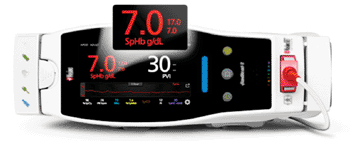Point-of-Care Hemoglobin Testing Compared with Laboratory Analyzer
By LabMedica International staff writers
Posted on 28 Jan 2014
Hemoglobin concentration is assessed to detect anemia and its associated morbidities and is usually determined from venous or capillary blood samples run on a laboratory analyzer.Posted on 28 Jan 2014
The blood sample method requires a needle stick and results can be delayed, and exposes caregivers to risks associated with needle sticks and blood exposure. Noninvasive hemoglobin determination would be of benefit to patients and caregivers because it would allow for quick and painless point-of-care assessment.

Image: The noninvasive hemoglobin (SpHb) device (Photo image courtesy of Masimo Corp).
Clinical scientists at Long Beach Veterans Administration Healthcare System (CA, USA) enrolled 474 subjects in a study to compare a noninvasive hemoglobin concentration measurement method with the traditional technique. A noninvasive hemoglobin (SpHb) test device was placed on the subject's nondominant ring finger. The sensor was covered with an opaque shield to prevent optical interference. A noninvasive hemoglobin measurement was obtained from each subject. Perfusion index, finger temperature, and oxygen saturation (SpO2), measured by the noninvasive hemoglobin test device, were also recorded.
Immediately following the noninvasive testing, a venous blood sample was obtained and analyzed for reference hemoglobin value (Hb) with a laboratory hematology analyzer (LH 500, Beckman Coulter; Brea, CA, USA). A capillary blood sample was also obtained by finger stick within 15 minutes of the noninvasive reading and the venous sample and analyzed immediately with a HemoCue 201 point-of-care hemoglobinometer (Cypress, CA, USA). The noninvasive hemoglobin (SpHb) test device was the Pronto-7, version 2.19, with a rainbow 4D sensor, rev E, (Masimo Corp., Irvine, CA, USA).
The reference hemoglobin concentration ranged from 8.6 g/dL to 17.4 g/dL. Analysis of data from all subjects showed a bias ± standard deviation of −0.1 ± 1.1 g/dL for Pronto-7 SpHb and −0.1 ± 1.6 g/dL for HemoCue, compared with the hematology analyzer. SpHb could be used to safety screen between 73% and 95% of the population to rule out anemia, with SpHb values of ≥11.5g/dL to 13 g/dL and an additional 0.5% of the population to rule in anemia, with SpHb values of 7.5g/dL to ≤10 g/dL.
The authors concluded that their study shows noninvasive hemoglobin measurement with SpHb offers similar accuracy as another established point-of-care method, HemoCue, in an outpatient clinic environment. Its noninvasive and quick testing characteristics may translate into added benefits to patient care. The study was published on January 13, 2014, in the International Journal of Laboratory Hematology.
Related Links:
Long Beach Veterans Administration Healthcare System
Beckman Coulter
Masimo Corp.














